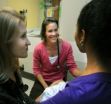(Press-News.org) Patterns fascinate. Particularly stripes. Found in nature in zebras, they are also found in the most unlikely places, such as powdered drugs' mixing vessel walls. In an article about to be published in EPJ E, Nirmal Thyagu and his colleagues from Rutgers University, New Jersey, USA, propose a traffic model to predict the formation of different patterns, ranging from stripes to spots.
Thanks to simulations, Thyagu and colleagues showed the underlying stripe formation mechanism, which they propose stems from traffic-like jams, whereby particles move more slowly when surrounded by other particles. This numerical model revealed three distinct patterns of how "sticking" can occur. These include stripe formation, clearing of surfaces between stripes, sharpening lead edges of the stripes, and stripe-to-spot transitions. These results were subsequently confirmed through experiments.
What is more, the authors found, striped patterns invariably form, provided that the relative humidity is in a range between 40 and 60%, and the tumbler surface is sufficiently rough enough to give hold to an initial layer.
Striped patterns formed by particles limit micro-patterned circuit size in electronics, inhaled medicines' effectiveness and polymer manufacturing efficiency. These patterns also adversely affect pharmaceutical manufacturing, as stripes appear on the walls of mixing vessels used for the production of powdered drugs.
More specifically, the authors also showed that active pharmaceutical ingredients can preferentially stick to mixing vessels' walls, and can carry as much as twice the concentration of active ingredients. As a result, the bulk powder used for tablets is less concentrated than it should be, or can be too concentrated if the highly concentrated material falls back into the bulk. Research focusing on how the effect carries over when scaling up to pilot- and full-scale manufacturing is currently underway.
### Reference:
N. N. Thyagu, A. Vasilenko, A. Voyiadjis, B. J. Glasser, T. Shinbrot (2012), Stuck in traffic: patterns of powder adhesion, European Physical Journal E 35:105, DOI: 10.1140/epje/i2012-12105-y
For more information, please visit www.epj.org
The full-text article is available to journalists on request.
The hidden threat posed by inconspicuous stripes
Physicists investigate the cause of striped patterns formed by fine particles deposited on surfaces
2012-10-22
ELSE PRESS RELEASES FROM THIS DATE:
Saving time, saving lives
2012-10-22
Istanbul, 22 October 2012: Experts in emergency cardiac care from around the world met in Istanbul to discuss ways to improve outcomes in patients with acute cardiac disease. This was the first annual meeting of the newly launched Acute Cardiovascular Care Association (ACCA) of the European Society of Cardiology (ESC) (1). The congress concludes today.
"The key message is that time saves lives," said Professor Tom Quinn, United Kingdom, member of the ACCA Board. "In cardiac emergencies, such as a heart attack, calling an ambulance immediately ensures the patient gets ...
Immune cells of the blood might replace dysfunctional brain cells
2012-10-22
This press release is available in German.
The immune system is comprised of multiple cell types each capable of specialized functions to protect the body from invading pathogens and promote tissue repair after injury. One cell type, known as monocytes, circulates throughout the organism in the blood and enters tissues to actively phagocytose (eat!) foreign cells and assist in tissue healing. While monocytes can freely enter most bodily tissues, the healthy, normal brain is different as it is sequestered from circulating blood by a tight network of cells known as the ...
Mock clinical exams boost pediatric residents' comfort in addressing breastfeeding
2012-10-22
AUGUSTA, Ga. – A simulated clinical experience guiding future pediatricians through interactions with breastfeeding moms appears to put the doctors at ease with the sensitive and important health topic, researchers say.
"We showed that their confidence and comfort increased with the OSCE (Objective Structured Clinical Examination) interventions," said Dr. Kathryn McLeod, a pediatrician and educator at the Medical College of Georgia at Georgia Health Sciences University who developed the three simulated patient exams.
Breastfeeding education typically falls to pediatricians ...
Gastric bypass surgery just as effective in teenagers as in adults
2012-10-22
Teenagers with severe obesity can benefit from gastric bypass surgery just as much as adults. A study by Sahlgrenska Academy, University of Gothenburg, Sweden and Karolinska Institutet, Sweden found that 81 teenagers lost an average of 96.8 pounds following surgery, significantly improving their health and quality of life.
The study, published by the International Journal of Obesity, involved eighty-one 13-18 year-olds who had gastric bypass surgery, which had previously been performed on people younger than 18 in exceptional cases only.
The new study found that gastric ...
Want the shortest path to the good life? Try cynicism
2012-10-22
Are cynics and happiness mutually exclusive? For modern cynics, perhaps. But for the ancient Cynics, not necessarily.
Research by the University of Cincinnati's Susan Prince shows that despite the historical perception of the ancient Cynics as harsh, street-corner prophets relentlessly condemning all passersby and decrying society's lack of virtue, these Greek philosophers, indirectly descended from Socratic teaching, weren't all doom and gloom. They actually might have espoused a shortcut to happiness.
"We don't have good scholarship on the Cynics. They're seen as ...
Rejecting arsentate
2012-10-22
Not long ago, some unassuming bacteria found themselves at the center of a scientific controversy: A group claimed that these microorganisms, which live in an environment that is rich in the arsenic-based compound arsenate, could take up that arsenate and use it – instead of the phosphate that all known life on Earth depends on. The claim, since disproved, raised another question: How do organisms living with arsenate pick and choose the right substance?
Chemically, arsenate is nearly indistinguishable from phosphate. Prof. Dan Tawfik of the Biological Chemistry Department ...
3D structure of an unmodified G protein-coupled receptor in its natural habitat
2012-10-22
Scientists have determined the three-dimensional structure of a complete, unmodified G-protein-coupled receptor in its native environment: embedded in a membrane in physiological conditions.
Using NMR spectroscopy, the team mapped the arrangement of atoms in a protein called CXCR1, which detects the inflammatory signal interleukin 8 and, through a G protein located inside the cell, triggers a cascade of events that can mobilize immune cells, for example.
Because G protein-coupled receptors are critical for many cellular responses to external signals, they have been ...
Stem cell bodyguards
2012-10-22
Hiding deep inside the bone marrow are special cells. They wait patiently for the hour of need, at which point these blood forming stem cells can proliferate and differentiate into billions of mature blood immune cells to help the body cope with infection, for example, or extra red blood cells for low oxygen levels at high altitudes. Even in emergencies, however, the body keeps to a long-term plan: It maintains a reserve of undifferentiated stem cells for future needs and crises. A research team headed by Prof. Tsvee Lapidot of the Institute's immunology Department recently ...
Alarming increase in malignant melanoma on the west coast of Sweden
2012-10-22
Malignant melanoma is as much as 35% more common among people who live in Gothenburg and the region's coastal municipalities than those who live inland. Researchers at Sahlgrenska Academy, University of Gothenburg, Sweden, have found that the number of malignant melanoma cases in the Västra Götaland region has quadrupled since 1970.
Malignant melanoma has become increasingly common in the Western world over the past few decades. One of the biggest factors has been excessive and unprotected sunbathing despite widespread awareness of the health risks.
Melanoma takes a ...
Immune cells make flexible choices
2012-10-22
Our immune system must be tremendously complex to respond to the unending assault of viruses, bacteria and cancerous cells. One of the mechanisms used by the immune system to cope with the huge variety of possible threats is to randomly combine DNA segments for the production of receptors on lymphocytes – a type of white blood cell. The number of possible receptors that can be produced in this way is about 1000 times the number of stars in our galaxy – one followed by 15 zeroes. And yet, the actual array of receptors produced does not conform to this picture of random chance: ...
LAST 30 PRESS RELEASES:
UMass Amherst chemists develop unique tool for studying RNA
Disappointment alters brain chemistry and behavior
A built-in odometer: new study reveals how the brain measures distance
Stress-related brain signals drive risk of cardiovascular disease in people with depression and anxiety
New details on role of fat transport molecules in Alzheimer’s onset
Study illuminates how an antiviral defense mechanism may lead to Alzheimer’s disease
Spot the males: New gene-editing method could transform mosquito control
AI learns to build simple equations for complex systems
NAU team releases 13 years of detailed U.S. CO2 emissions data
Unveiling how sodium-ion batteries can charge faster than lithium-ion ones
How do childcare tax credits affect children’s long-term health?
Can an electronic nose detect indoor mold?
Do natural disasters have long-term impacts on mortality in older adults?
Modification improves sodium‐ion batteries as an alternative to lithium-ion batteries
Parasports provide a range of benefits for people with cerebral palsy
How does grandparental care affect children’s health?
Why are there so many Nordic mediators?
Young shark species more vulnerable to extinction
Mobile fetal heart monitoring linked to fewer newborn deaths in Tanzania
Bluey’s dad offered professorial chair in archaeology at Griffith University
Beyond small data limitations: Transfer learning-enabled framework for predicting mechanical properties of aluminum matrix composites
Unveiling non-thermal catalytic origin of direct current-promoted catalysis for energy-efficient transformation of greenhouse gases to valuable chemicals
Chronic breathlessness emerging as a hidden strain on hospitals
Paleontologists find first fossil bee nests made inside fossil bones
These fossils were the perfect home for ancient baby bees
Not everyone reads the room the same. A new study examines why.
New research identifies linked energy, immune and vascular changes in ME/CFS
Concurrent frailty + depression likely boost dementia risk in older people
Living in substandard housing linked to kids’ missed schooling and poor grades
Little awareness of medical + psychological complexities of steroid cream withdrawal
[Press-News.org] The hidden threat posed by inconspicuous stripesPhysicists investigate the cause of striped patterns formed by fine particles deposited on surfaces

